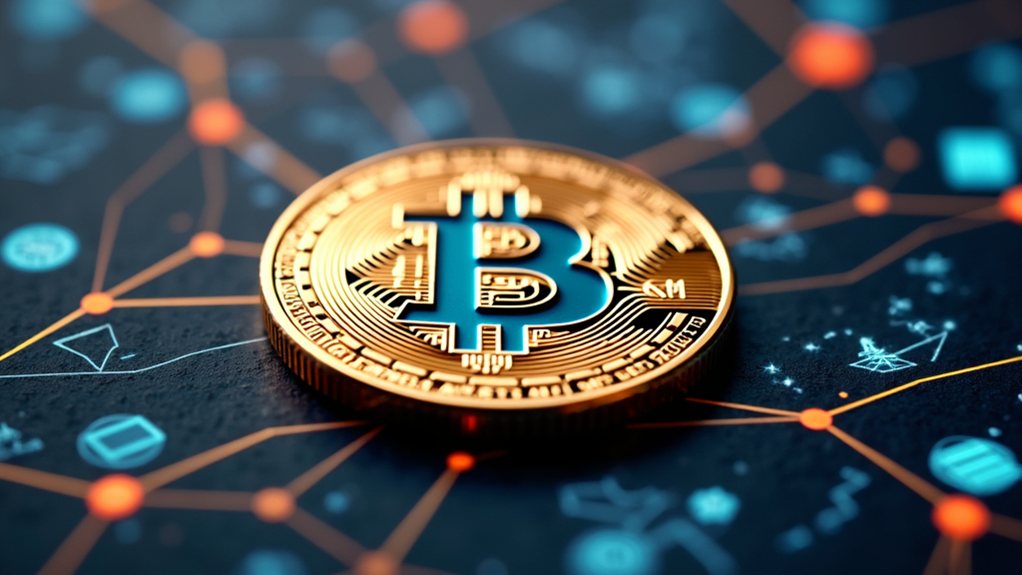Avalanche is a blockchain platform launched in 2020 by Ava Labs. It uses a Proof of Stake system to provide fast transactions with low fees. The network consists of three chains: X-Chain for assets, C-Chain for smart contracts, and P-Chain for validators. Avalanche can process up to 4,500 transactions per second with sub-second finality. It's compatible with Ethereum applications and supports DeFi, NFTs, and gaming projects. Further exploration reveals how Avalanche stands out from competitors.

While many cryptocurrencies struggle with slow speeds and high fees, Avalanche has emerged as a leading Layer 1 blockchain solution focused on solving these problems. Launched in 2020 by Ava Labs, Avalanche uses a Proof of Stake consensus mechanism that enables fast transactions with low fees. Its native token, AVAX, serves multiple functions within the ecosystem.
Avalanche's architecture consists of three interconnected blockchains. The X-Chain handles asset exchanges, the C-Chain supports smart contracts, and the P-Chain coordinates network validators. This unique design helps Avalanche process up to 4,500 transactions per second with sub-second finality, making it much faster than older blockchains like Bitcoin and Ethereum.
Avalanche's three-chain architecture enables blazing 4,500 TPS with near-instant finality – leaving Bitcoin and Ethereum in the dust.
The AVAX token is central to how Avalanche works. Users pay network fees with AVAX, stake tokens to secure the network, and participate in governance decisions. AVAX also enables the creation and management of subnets, which are customizable blockchains built on Avalanche. The total supply of AVAX is capped at 720 million tokens, and transaction fees get burned, potentially reducing supply over time.
Avalanche uses a consensus mechanism called the Snow protocol family. Unlike traditional systems, validators "gossip" with each other and use random sampling to reach agreement. This approach maintains security while achieving higher speeds than many competing blockchains. It's also more energy-efficient than the mining-based systems used by Bitcoin and early versions of Ethereum. The platform has maintained its commitment to fastest time to finality since its inception, which makes it particularly suitable for financial applications.
One of Avalanche's key strengths is its compatibility with Ethereum's Virtual Machine (EVM). This means developers can easily move their Ethereum applications to Avalanche with minimal changes to code. Many projects have done exactly this to benefit from lower fees and faster transactions. The platform also offers bridges that let users transfer assets between different blockchain networks.
Avalanche has gained adoption across several areas of the crypto ecosystem. It hosts decentralized finance (DeFi) applications where users can lend, borrow, and trade digital assets. Users can participate in yield farming opportunities to earn passive income from their AVAX holdings, similar to other DeFi platforms. The platform supports NFT marketplaces where digital art and collectibles are bought and sold. Gaming companies and metaverse projects also use Avalanche for its speed and reliability. As an open-source project, Avalanche allows anyone to view and contribute to its underlying code.
Compared to competitors, Avalanche offers distinct advantages. It processes transactions faster than Bitcoin and Ethereum while charging lower fees. Its subnet technology allows organizations to create custom blockchains for specific purposes, a feature not widely available elsewhere. Avalanche also emphasizes interoperability, making it easier for different blockchain systems to work together.
As blockchain technology continues to evolve, Avalanche positions itself as a scalable, efficient option for developers and users alike. Regular network upgrades improve functionality while maintaining the core features that have made it a significant player in the cryptocurrency landscape.
Frequently Asked Questions
How Does Avalanche Compare to Ethereum for Developers?
For developers, Avalanche offers several advantages over Ethereum. It processes transactions much faster (4,500+ TPS versus Ethereum's 15-30 TPS) with sub-second finality.
Avalanche's fees are considerably lower, averaging $0.23 compared to Ethereum's $2-$15+. Both platforms support Solidity and are EVM-compatible, making migration easy.
Avalanche's subnets allow developers to create customized blockchains, while Ethereum has a larger ecosystem of development tools.
What Are the Security Risks of Avalanche's Subnets?
Avalanche's subnets face several security risks. Their smaller validator sets make them more vulnerable to attacks or collusion.
Customizable Virtual Machines may introduce new attack vectors without standardized security audits.
Cross-subnet communication can create vulnerabilities, while fragmented liquidity complicates asset management.
Regulatory compliance varies between subnets, potentially enabling regulatory arbitrage.
Some projects might prioritize performance over decentralization, risking centralized control and validator monopolies in specialized subnets.
Can Avalanche Tokens Be Staked for Passive Income?
Yes, AVAX tokens can be staked for passive income.
Investors need a minimum of 25 AVAX to start staking. The process involves locking tokens for periods ranging from 14 to 365 days.
Current reward rates typically fall between 8-10% APY. Stakers can choose multiple methods including direct staking through Avalanche wallet, delegating to validators, or using exchanges.
Funds remain locked during the staking period, and rewards compound automatically.
How Does Avalanche's Energy Consumption Compare to Bitcoin?
Avalanche's energy consumption is dramatically lower than Bitcoin's. It uses just 0.0005% of Bitcoin's energy, consuming about 470,000 kWh annually—equivalent to 46 U.S. households.
Bitcoin consumes 127-150 TWh yearly, similar to Poland's entire electricity use.
While Avalanche processes 4,500 transactions per second with 2-second finality, Bitcoin handles only 5-7 TPS with 10-minute block times.
Avalanche's efficiency comes from its Proof-of-Stake mechanism.
What Partnerships Is Avalanche Developing in the Defi Space?
Avalanche has formed key partnerships in DeFi.
Aave deployed on Avalanche in 2021, migrating $4 billion in liquidity within three months.
Curve Finance launched on the network, boosting TVL by $1.5 billion in its first month.
Trader Joe, a native Avalanche DEX, reached $2.5 billion TVL with innovative features like Liquidity Book AMM.
GMX, a perpetual exchange, achieved $500 million in daily trading volume on Avalanche.










